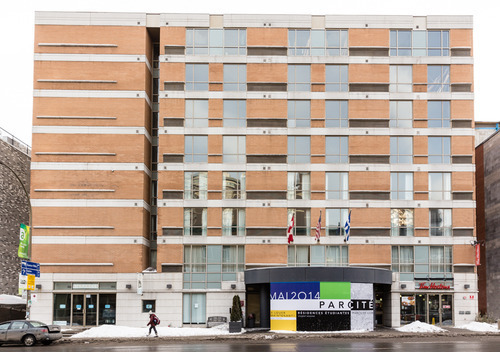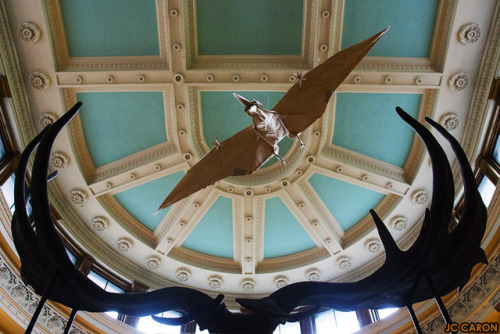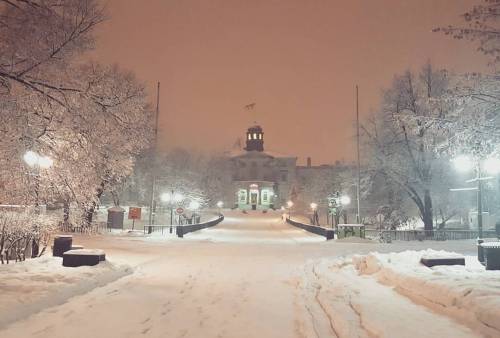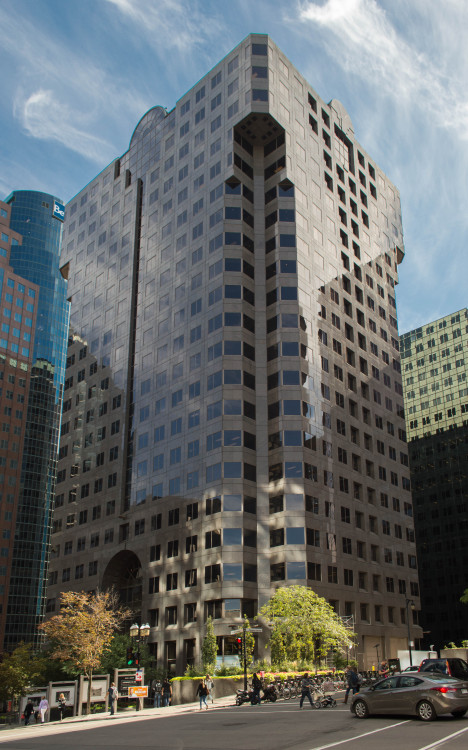#mcgill
Origami d'un ptéranodon de 4m d'envergure, réalisé par Robert J. Lang à partir d'une seule feuille de papier (géante ?), volant au dessus de bois, géants eux aussi, de caribou - musée Redpath - Université McGill - Montréal
*****************
Origami of a pteranodon of 4m wingspan, made by Robert J. Lang from a single giant sheet of paper , Flying over caribou antlers, giants too - Redpath Museum - McGill University - Montreal
Post link
Snowy McGill
#montreal #quebec #mcgill #university #architecture #snow #winter #winternight #city #night #urban #campus #street #streetlight #neige #white #winterwonderland #glow #shiny #canada #pink #cityscape #inspiring #education #backtoschool #january #meteoqc #instamoment #wonderland (at McGill University)
Post link
by LockOutPetrocultures |Dismantling the Debate

Environmental justice activists take-over and drop banner (above) from the building where McGill University was hosting its annual fossil fuel conferance, February 7, 2014 – Photo via @LockoutPetroC
MONTREAL – On February 6 and 7, 2014, McGill University’s Institute for the Study of Canada is hosting a conference entitled “Petrocultures: Oil, Energy, and Canada’s Future,” which brings together leading members of the fossil fuel industry, consultants, supporters of oil extraction in various forms, as well as critics of fossil fuel extraction. These critics believe that the solutions to the environmental and human crises caused by petrochemicals and their extraction lie in reasoned debate.
The framework of this conference positions support for fossil fuel extraction as one valid opinion among others, reducing massive environmental destruction, widespread death and disease, and the continued advancement of Canada’s colonial project to intellectual concerns, to be balanced against the promise of cheap energy and growth in profits. No matter their personal convictions, participants in such debate legitimate the pro-tar sands, pro-fracking, colonialist position by granting its defenders a speaking platform and a considered response.
To ask whether Canada should or should not engage in fossil fuel extraction is to distract from the vital question of how we (as people living in Canada and as residents of a shared planet) will shut down fossil fuel extraction and the economy it supports as quickly as possible. Petrocultures’ choice of starting point for the conversation is a political choice with important effects.
In solidarity with blockades and lockdowns of pipelines and extractive projects across Turtle Island, we are locking out Petrocultures 2014 and the academic discourses that legitimize and facilitate the continued destruction of the atmosphere and pillaging of the planet.
The structure of the Petrocultures debate is not neutral. It presumes a position of political authority, an ability to influence policy as it relates to labour mobility, free trade, and urban design among other topics. Accordingly, a quick scan of the speakers list reveals that participation is contingent on expertise and public status. Just as the debate structure reduces to an afterthought the lived experiences of people suffering the worst effects of resource extraction, the $150 price of admission serves to exclude any participants who might diverge from the script. Any discussion on how to relate to extractive industries must revolve around the people who will be most directly affected by extreme climate change, not paid experts, policymakers, and ivory tower academics.
To whom does Petrocultures offer a stage? Beyond outright promoters of the tar sands and fracking: a co-founder of ForestEthics, which advocates for “responsible industry,” a co-founder of Équiterre, which urges “responsible consumption,” and the president of the International Institute for Sustainable Development, which campaigns to achieve “green growth.” The common thread uniting these speakers is a commitment to making moderate adjustments to life under capitalism, adjustments which serve to extend the lifespan of an inherently violent system without abolishing it. Capitalist society is predicated on indefinite growth and extreme inequality. It cannot exist without the continued refinement of techniques of social control or organized violence. Gradual reforms that leave the basic structure in tact, as pursued by environmental NGOs committed to “sustainability” and “a better future”, are not merely inadequate, they act in opposition to our struggles for lives free from domination and for a planet that will continue to sustain life. Neither do demands for a “sustainable” Canadian future, with their presumptions of an ongoing nation-state and ongoing settler presence on Native lands, address the imperative to dismantle the colonial apparatus of this country.
Let us not forget Suzanne Fortier, who would have had the honor of opening proceedings today. While the world’s largest industrial project displaces indigenous communities and raises the incidence of rare and fatal cancers among their people, Fortier has worked tirelessly to give industry in general and the extractive sector in particular greater control over academic research, as president of the granting agency NSERC then as principal of McGill. Her role in cementing the complicity of universities in ongoing colonization and destruction of the earth makes it fitting that she would address Petrocultures, which, like her vaunted corporate partnerships, sees in the catastrophe of the tar sands an opportunity to generate institutional prestige.
It is not impossible that a participant in Petrocultures would utter a challenge to the systemic roots of the building ecological catastrophe. Yet the structure of the conference would have defused that challenge’s radical potential in advance, flattening it into an academic contest of ideas, opinions to be weighed against one another, prompting ever more contemplation and reasoned dialogue. Meanwhile, the pace at which tar sands projects poison the food people eat, contaminate their water supply, and annex unceded indigenous land only accelerates.
A growing scientific consensus confirms what the brutality of a petro-economy makes apparent in a million ways everyday: time has run out. Rather than wait for a political solution that will not come, we want to spread resistance to the tar sands and to all other forms that Canadian capitalism and colonialism take in our communities and daily lives. And we want to interrupt the falsely critical dialogues that legitimize the power of the people who are destroying the earth. We know that today’s action is a small one, that much more is needed. We hope that others will see in our resistance a shared call to action.
February 7, 2014
by Hera Chan and Carla Green |The McGill Daily

One of the hotels neighboring McGill University set to be converted into student housing this fall.
MONTREAL, Quebec – When the Holiday Inn on Sherbrooke and the Delta Centre-Ville hotel on University re-open this fall, they will be home to hundreds of university students, joining the recent trend of converting hotels to student housing in the area around McGill campus and the downtown area.
The making of the ‘McGill Ghetto’
Despite the recent news, the neighborhood around McGill hasn’t always been so student-laden. Over the years, it morphed from a working-class neighborhood to a home for hippies, draft dodgers, and counterculture. Finally, in the mid-1990s, it became the expensive, student-filled ‘McGill Ghetto’ that we know today.
According to an interview published in Satellite magazine in 2012, Phyllis Lambert, founder of the Canadian Centre for Architecture, said, “In the [19]70s through the [19]80s, there was a huge not-for-profit cooperative housing project for about 600 to 700 people just to the east of the McGill campus, in the downtown.”
Lucia Kowaluk, president of the Milton Parc Citizens’ Committee, said that she has lived in the neighborhood since its ‘hippie’ days in the 1960s, when she was a student at McGill’s School of Social Work. “McGill was small at the time,” she said in an interview with The Daily. “Not many students lived there.”
Now, with almost 40,000 students enrolled at McGill as of 2013, student housing has become a central issue in the neighborhood. Notably, private investors, rather than university residence systems, are currently the most active in the student housing market. Campus Crest Communities Incorporated – one of the investors in both the Holiday Inn and Delta transformations – is a major player, with a 35 percent stake in the Holiday Inn project and a 20 percent stake in the Delta project.
In an e-mail to The Daily, Ted Rollins, CEO of Campus Crest, wrote, “We have big plans for Canada. We believe that the Canadian market is in need of this type of project. We have already experienced a tremendous amount of interest from students.”
As the McGill student population continues to grow, the University has also been rapidly expanding its residence network. Three hotels have been converted to residences in less than ten years: New Residence Hall, Carrefour Sherbrooke, and La Citadelle, in that order. In addition, private investors from Toronto and the United States have plans to convert the Quality Inn on Parc to a student residence in the near future.
According to Éric Michaud, coordinator at the Comité logement Ville-Marie, a housing advocacy group in the downtown core, the flood of students into the areas around the McGill campus has made it less accessible for families to live there.
“[The growth of the student population] diminishes the accessibility of housing for families because students can split the costs and pay more than a family could for the same space,” he said in French in an interview with The Daily.
Conversely, Kowaluk isn’t worried about the ongoing hotel-student residence conversions. “That’s fine,” she said. “From the board chatting about it, we’re glad that students are moving into hotels so they don’t take over [the neighborhood’s] Victorian houses.”
Michaud somewhat agreed, saying, “Unfortunately, there’s not enough student housing built by the universities,” he said. “We think that it’s a good thing to have student residences built by universities because [then] students pay less [for it].”
For an individual student, the average rent for a double room, shared with an assigned roommate, at New Residence Hall, Carrefour Sherbrooke, or La Citadelle, is $1087.67 per month, with La Citadelle the most expensive at $1112 per month.
Rollins declined to specify exactly how expensive the converted Holiday Inn residence would be, writing only, “We aren’t the cheapest, but we believe that students will receive a compelling value.”
“McGill is a terrible landlord. There are things you have to pay for that would never stand up if they had to face a renting board,” said Fred Burrill, community organizer at Projet Organisation Populaire Information et Regroupement (POPIR) of the St. Henri, Petite Bourgogne, Côte-Saint-Paul, and Ville-Émard areas.
Prime real estate
In recent years, McGill has turned to hotels to build cheaper residences, with all three of its most recent residences the product of such renovations. While these residences may take students out of the renting pool for private apartments, it won’t necessarily drive rent down in the apartments they would be leaving behind.
Paule Provencher, a real estate agent in the McGill area for around 25 years, said that after the renovation that turned the former Renaissance Hotel into New Residence Hall several years ago, there were far fewer students looking to rent, but that the dip in demand had little impact on rent prices in the neighborhood.
“[The prices go down] a little bit, but not that much,” she told The Daily. “You have to understand that people have purchased their condo at a high price and they really cannot just give it away.”
“Families and professional couples don’t want to [live in the McGill area]. When I tell them that it’s in [that] area, they say ‘no thank you.’ They hang up,” she said, adding, “Just a few families live in the area, but really not that much.”
“A trend that has been happening in the last couple years in Montreal, roughly since when McGill opened up Solin Hall [in 1990], is that universities – and McGill is on the forefront of this – are becoming developers, even if not for-profit, making the neighborhoods more upscale,” said Burrill, adding that, “The university as developer is a phenomenon that McGill started but is no longer the only participant in the process.”
A soon-to-be-released study, conducted by the Comité in conjunction with the Université du Québec à Montréal, indicated that in the borough of Ville-Marie (which includes most of the Golden Square Mile), property prices have soared since 2004.
“They have doubled between 2004 and 2011, which has had an impact on, among other things, [property] taxes and rent [in the neighborhood],” said Michaud.
It’s not only renters who pay the price of the shift to private investors in the residence market. “I think that as universities like McGill and Université de Montréal are moving increasingly toward the corporate model, they need revenue streams. That comes with increase in tuition, increase in ancillary fees that McGill has students have to pay,” said Burrill.
It’s unclear exactly what impact private investment will have on the situation, but Provencher said that if it will impact rent prices in the neighborhood, it would most likely drive them up even further.
“If it’s a private [company], of course they’re making an investment; they want money, and [residences] they develop will probably be more expensive than McGill’s,” Provencher said.
The students’ legacy
Despite the dizzying climb of rent prices in the McGill area since the 1990s, a typical feature of gentrification, both Provencher and Kowaluk argued that the neighborhood hasn’t been gentrified.
“I don’t see students moving in as gentrification,” said Kowaluk, although she wasn’t happy about the change.
Provencher agreed. “I don’t think [of it as gentrification]. Because the families with kids, they don’t want to come [to the neighborhood], the professionals, they don’t want to come,” she said.
“The number of students is overwhelming the demographic mix,” Kowaluk added. “It’s not the majority of students, but enough who don’t have a sense of living in a neighborhood [and] don’t know how to behave or hold their liquor […] I know people who say their neighbors have left because they were tired of the noise.”
Burrill described McGill’s view on incoming students as a “captive tenant population,” saying that “[The University] is targeting them as a revenue source.” Burrill believes that the conversion of hotels to residences downtown do contribute to a form of gentrification, pushing lower-income tenants out.
“The main way students can not contribute to gentrification is living a certain way, getting to know their neighbours,” he said. “There are certain legal things student[s] can do. You can transfer your lease, insist on having repairs done.”
Information Studies/McGill University
Evelina: A Life-Story of a Book, Told by Its Paratext.
Cafe Castel
Location: 1015 Sherbrooke Street West
Metro Station: Peel
Attention all McGill students. This next one’s for you.
It was a cold fall’s day… a Friday… during my 4 hour break from school. I decided to go on an excursion to a new cafe… but things started going awry… Okay, I sound way too dramatic.
But really, I was never suppose to come here in the first place. I had decided to go to Humble Lion that day. I heard its a McGill student central since it’s right next to McGill… that shouldv’e been my first warning. What was I thinking? Going to Humble Lion on a Friday afternoon in the middle of midterms (sorry for mentioning the ‘m’ word in the during the holidays, won’t happen again, I promise). It was obviously full when I got there. I walked around, pretty disappointed. It was cold. And I had a heavy bag. And was desperate for some coffee.
On my way back to Concordia, I saw a shop with beautiful windows that drew me in: Cafe Castel. I decided to give it a try even though it wasn’t on my list at the time. It’s good to do things beyond lists sometimes.
Going in, I was surprised to see that the place offered a lot off seating.. with not many people inside. Compared to Humble Lion, it was pretty deserted. But this did not reflect the quality of the cafe.
I obviously sat next to the huge window, below the gorgeous skylight. The lightingin this cafe is definitely the highlight,haha, get it? Anyways, bad jokes set aside, this place is seriously beautiful. And their pretty latte art just made it even better! The barista caught me taking lots of pictures of their decor and really loved my photography: friendly staff! It’s always lovely to meet great baristas.
Another great aspect of this cafe is (probably) the food. It looked pretty good and whoever came in tended to get food instead of a drink. This said, it’s not your typical basic cafe, it’s more of an eating cafe… if that makes sense? Coffee’s good though, don’t worry. And it was a great place to study.
It’s also connected to a hotel, which is cool.
After visiting this cafe, I checked their location on Instagram and found out that it is in fact a well known cafe. Some of the pictures I saw had really cool latte art. Like bears and stuff. On your coffee. I hope I get a bear on my latte next time… Hope you get one too when you visit! ;)
Post link

McGill University

McGill University // Montreal // Canada - by Ryan Jackman








